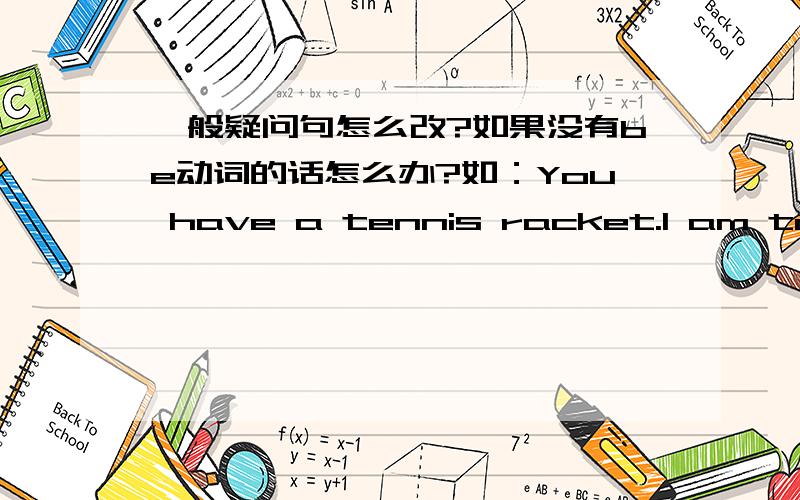一般疑问句怎么改?如果没有be动词的话怎么办?如:You have a tennis racket.I am tom.还有,对划线部分提问怎么做?举个例子和具体做法好的追加50分!
来源:学生作业帮助网 编辑:作业帮 时间:2024/11/16 11:39:33

一般疑问句怎么改?如果没有be动词的话怎么办?如:You have a tennis racket.I am tom.还有,对划线部分提问怎么做?举个例子和具体做法好的追加50分!
一般疑问句怎么改?如果没有be动词的话怎么办?如:You have a tennis racket.I am tom.
还有,对划线部分提问怎么做?举个例子和具体做法
好的追加50分!
一般疑问句怎么改?如果没有be动词的话怎么办?如:You have a tennis racket.I am tom.还有,对划线部分提问怎么做?举个例子和具体做法好的追加50分!
没有就用 do啊 Do you have.
一、含有be动词的一般疑问句,通常把be动词调到句首。例如:
陈述句:They are in the swimming pool.
一般疑问句:Are they in the swimming pool?
注意:一般疑问句句末要用“?”。
二、含有情态动词的一般疑问句(can, may...),把情态动词调到句首。例如:
陈述句:He can dr...
全部展开
一、含有be动词的一般疑问句,通常把be动词调到句首。例如:
陈述句:They are in the swimming pool.
一般疑问句:Are they in the swimming pool?
注意:一般疑问句句末要用“?”。
二、含有情态动词的一般疑问句(can, may...),把情态动词调到句首。例如:
陈述句:He can drive a car.
一般疑问句: Can he drive a car?
三、含有have的一般疑问句,have译为“有”。一般疑问句式有两种形式:
1.把have/has调到句首。例如:
陈述句:Tommy has a computer.
一般疑问句:Has Tommy/he a computer?
2.加助动词do/does,第三人称单数用does,其他人称用do。其句型为:Do/Does + 主语 + have...?例如上句可变为:
Does Tommy have a computer?
四、一般动词的一般疑问句,也要借助助动词do/does,第三人称单数用does,其余人称用do。其句型为:Do/Does + 主语 + 动词原形+其它?
陈述句:Amy speaks English.
一般疑问句:Does Amy speak English?
好了,知道了如何问话之后,我们来了解一下如何回答一般疑问句。首先要有人称的改变。当主语为名词时,在答语中要改成其相应的代词。另外,答语有两种,肯定的回答(用yes)和否定的回答(用no),否定式常用缩写形式。现在还是让我们分句型一一说明。
一、一般疑问句含be动词时,用be动词回答,句末用句号。例如:
-Is Mary your sister?
-Yes, she is. / No, she isn’t.(缩写)
二、一般疑问句含有情态动词(can, may, should等)时,用情态动词回答。例如:
-May I come in?
-Yes, you may. / No, you can’t.
三、一般疑问句含有have(译为“有”)时,有两种回答方式。
1.直接用have/has回答。例如:
-Have they any pictures?
-Yes, they have. / No, they haven’t.
2.用助动词do/does回答。例如:
-Does Millie smoke?
-Yes, she does. / No, she doesn’t.
四、一般动词的一般疑问句回答时也用助动词。例如:
-Do the workers live in London?
-Yes, they do. / No, they don’t.
收起
1.没有be动词,有其它动词的话,用Do 或Does提问。
Do情况第一人称单数:I,第二人称单数:You,所有人称的复数:They。
You have a tennis racket.
改:Do you have a tennis racket?
She goes to bed now.
Does she go to bed now?
2.有be动...
全部展开
1.没有be动词,有其它动词的话,用Do 或Does提问。
Do情况第一人称单数:I,第二人称单数:You,所有人称的复数:They。
You have a tennis racket.
改:Do you have a tennis racket?
She goes to bed now.
Does she go to bed now?
2.有be动词,am /are/is这些be 动词
I am Tom
提问:Are you Tom?
I am , You are ,They are ,He is ,She is ,it is 这样搭配
收起
一般疑问句的解题技巧
首先我们要弄懂什么是一般疑问句式。当我们想说“你是……吗?”,“你做……了吗?”的时候,就要用一般疑问句式。为了便于同学们学习,我分类讲解一下一般现在时的一般疑问句式。
一、含有be动词的一般疑问句,通常把be动词调到句首。例如:
陈述句:They are in the swimming pool.
一般疑问句:Are they in the...
全部展开
一般疑问句的解题技巧
首先我们要弄懂什么是一般疑问句式。当我们想说“你是……吗?”,“你做……了吗?”的时候,就要用一般疑问句式。为了便于同学们学习,我分类讲解一下一般现在时的一般疑问句式。
一、含有be动词的一般疑问句,通常把be动词调到句首。例如:
陈述句:They are in the swimming pool.
一般疑问句:Are they in the swimming pool?
注意:一般疑问句句末要用“?”。
二、含有情态动词的一般疑问句(can, may...),把情态动词调到句首。例如:
陈述句:He can drive a car.
一般疑问句: Can he drive a car?
三、含有have的一般疑问句,have译为“有”。一般疑问句式有两种形式:
1.把have/has调到句首。例如:
陈述句:Tommy has a computer.
一般疑问句:Has Tommy/he a computer?
2.加助动词do/does,第三人称单数用does,其他人称用do。其句型为:Do/Does + 主语 + have...?例如上句可变为:
Does Tommy have a computer?
四、一般动词的一般疑问句,也要借助助动词do/does,第三人称单数用does,其余人称用do。其句型为:Do/Does + 主语 + 动词原形+其它?
陈述句:Amy speaks English.
一般疑问句:Does Amy speak English?
好了,知道了如何问话之后,我们来了解一下如何回答一般疑问句。首先要有人称的改变。当主语为名词时,在答语中要改成其相应的代词。另外,答语有两种,肯定的回答(用yes)和否定的回答(用no),否定式常用缩写形式。现在还是让我们分句型一一说明。
一、一般疑问句含be动词时,用be动词回答,句末用句号。例如:
-Is Mary your sister?
-Yes, she is. / No, she isn’t.(缩写)
二、一般疑问句含有情态动词(can, may, should等)时,用情态动词回答。例如:
-May I come in?
-Yes, you may. / No, you can’t.
三、一般疑问句含有have(译为“有”)时,有两种回答方式。
1.直接用have/has回答。例如:
-Have they any pictures?
-Yes, they have. / No, they haven’t.
2.用助动词do/does回答。例如:
-Does Millie smoke?
-Yes, she does. / No, she doesn’t.
四、一般动词的一般疑问句回答时也用助动词。例如:
-Do the workers live in London?
-Yes, they do. / No, they don’t.
对划线部分提问
第一步:根据划线部分的词、句确定特殊疑问词。whose, what , how , when , where ,why , which, who , because, how many, what colour, how much, how old ,how long, how often等。
注意:划线部分语句的意思就是你要变成的问句的答案,这是确定确定特殊疑问词的捷径。如:
1.Lily plays soccer every day.确定用what。
2.She cleaned room last night. 确定用when。
3.He is at home. 确定用where。
4.Her coat is red. 确定用what colour。
5.Tom’s bike is $ 50. 确定用how much 。
6.This is Lucy’s book. 确定用whose 。
7.She likes English because it is interesting. 确定用why
第二步:去掉画线部分。因为如果不去掉画线部分语句可能会造成你所问的句子前后矛盾。如:What’s your name Wang Wei? (你叫什么名字王伟?)
1.Lily plays soccer every day.
2.She cleaned room last night.
3.He is at home.
4.Her coat is red.
5.Tom’s bike is $ 50.
6.This is Lucy’s book.
7.She likes English because it is interesting.
第三步:把去掉划线部分后的句子变成一般疑问句,然后把它添加在特殊疑问词后,加上问号。
1.What does Lily play every day?
2.When did he clean room ?
3.Where is h e ?
4.What colour is her coat?
5.How much is Tom’s bike?
6.Whse book is this ?
7.Why does she like English?
大家要注意的几种特殊情况:
使用who时要分清主语和宾语:
(1.)如果是对主语提问只要用who替换主语部分就可以了,千万不要再改动其他的地方。
1.Tom does his homework yesterday.
Who does his homework?
(2.)如果对宾提问,仍然按规则变化。
Tom has helps me with my English.
WhoWhom does Tom help with English?
2.对句子中介词词组提问,要分清介词词组在句中的成分,以确定使用which 或者where:
(A)作状语时用where:
(1.)The book is on the desk.
Where is the book?
(2.)H e saw a book on the desk.
Where did he see a book?
(B)作状语时用which:
(1.) The man in the car is Tom’s father.
Which man is Tom’s father?
(2.) The book on the desk is mine
Which is your book?
3.使用whose时要分清它的后面有无名词:
This book is mine.
Whose is this book ?
This is my book.
Whose book is this?
3.使用how many ,how much的区别和具体的规则:分清划线部分是可数名词还是不可数名词。如果可数就用how many,如果不可数就用how much。
(1.)He has $10.
How much does he have?
(2.)They have 10 cats.
How many cats do they have?
4.用what 提问there be句型时要注意去掉there be:
There are 20 books in the room.
What are in the room?
5.有缺省的词情况的变化:
有缺省的词时要注意固定句型的准确选择和运用:
(1.)She played soccer last night.
What did she do last night?
(2.)He is a student.
What does he do?
(3.)Tom is looking at the picture.
(4.)What is Tom doing?
(5.)Lucy is of medium height.
What does Tom look like?
6.注意部分时态中实义动词的变化。
He plays the guitar every day.
Does he play the guitar every day?
They played tennis in the moring.
Did they play tennis in the moring?
收起
You have a tennis racket。
改为一般疑问句:Do you have a tennis racket?
对改为一般疑问句、对划线部分提问。你心须懂得四类动词,才能解决。
我是英语教师,在此作详细的解说,你提交了,我白做。所以就不一一作解释了。可在短信句。